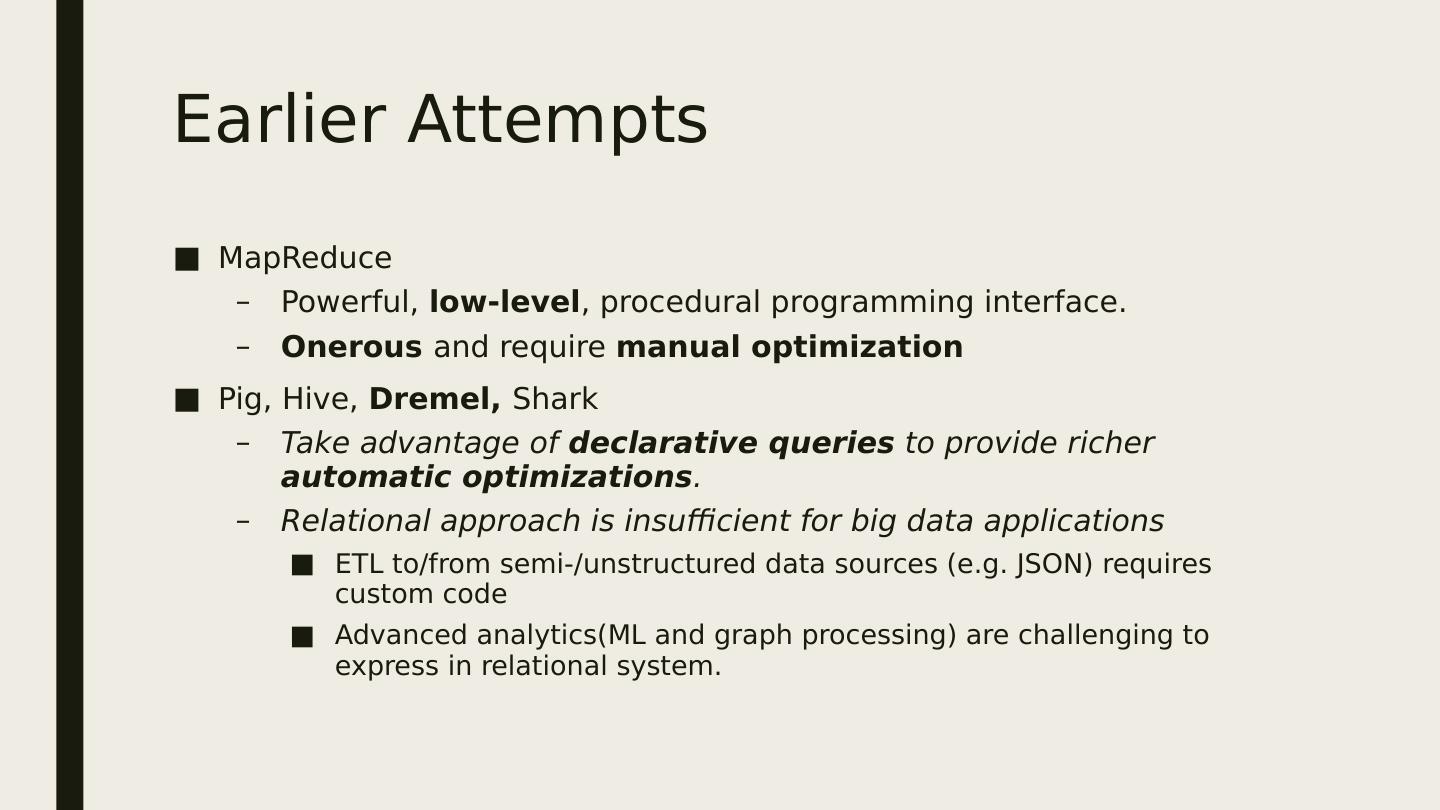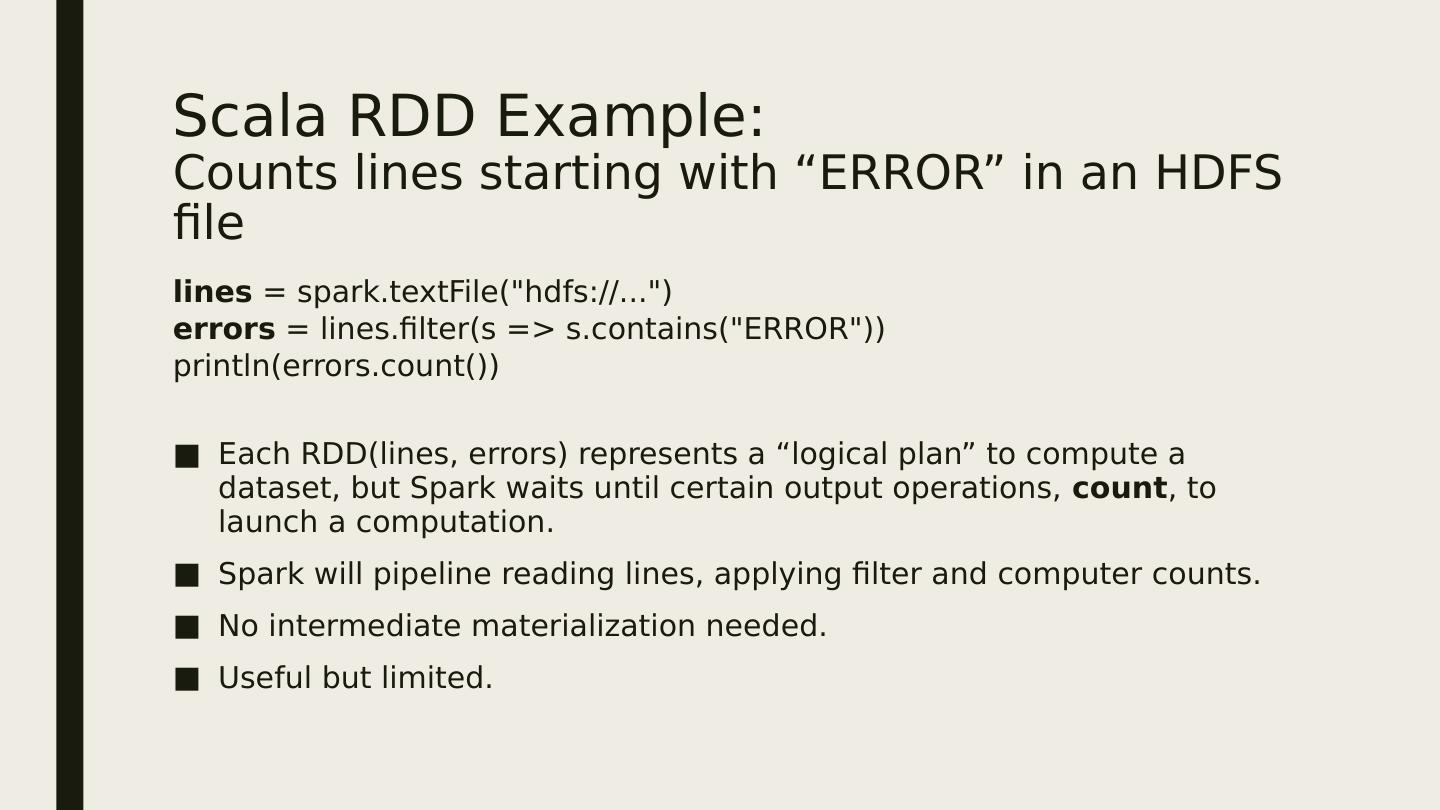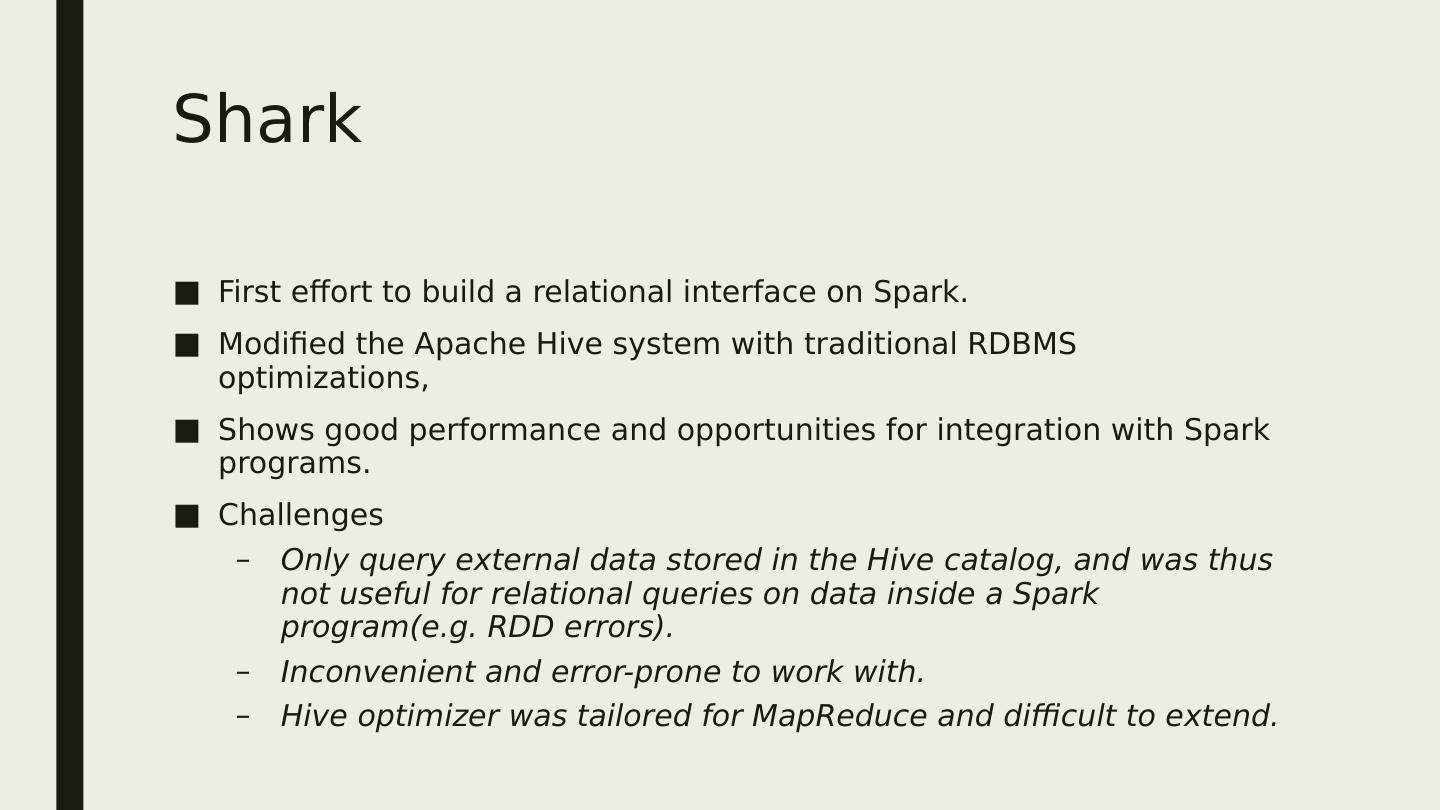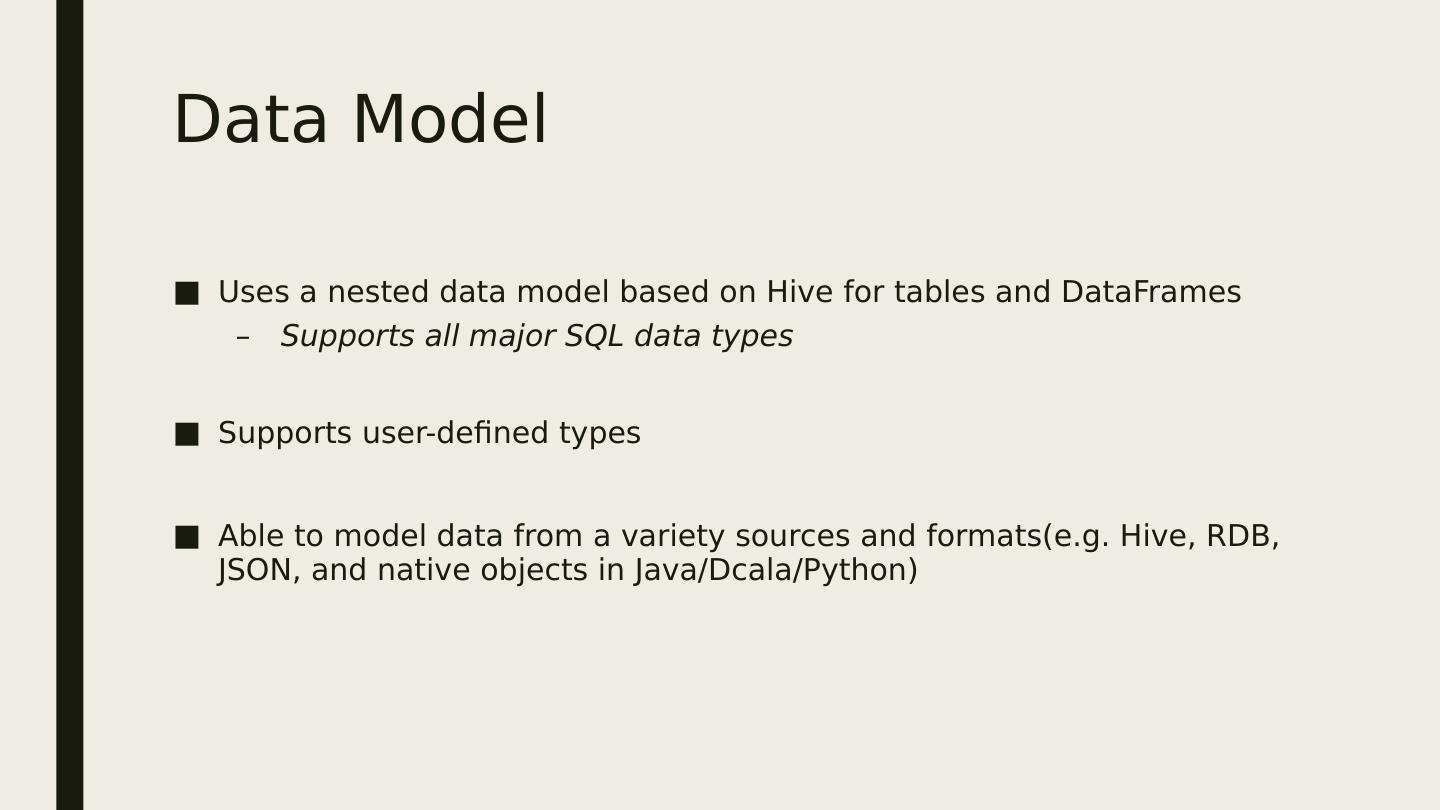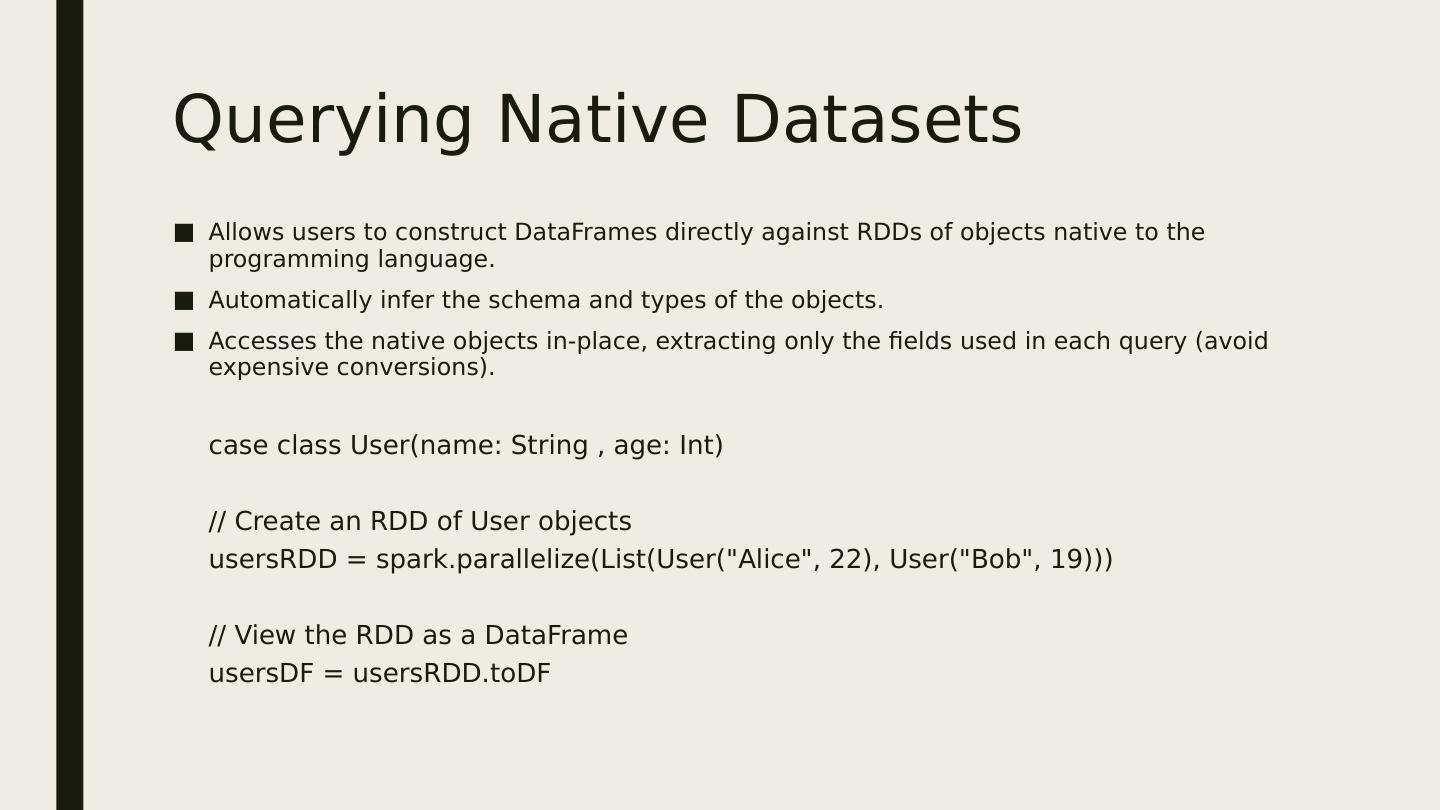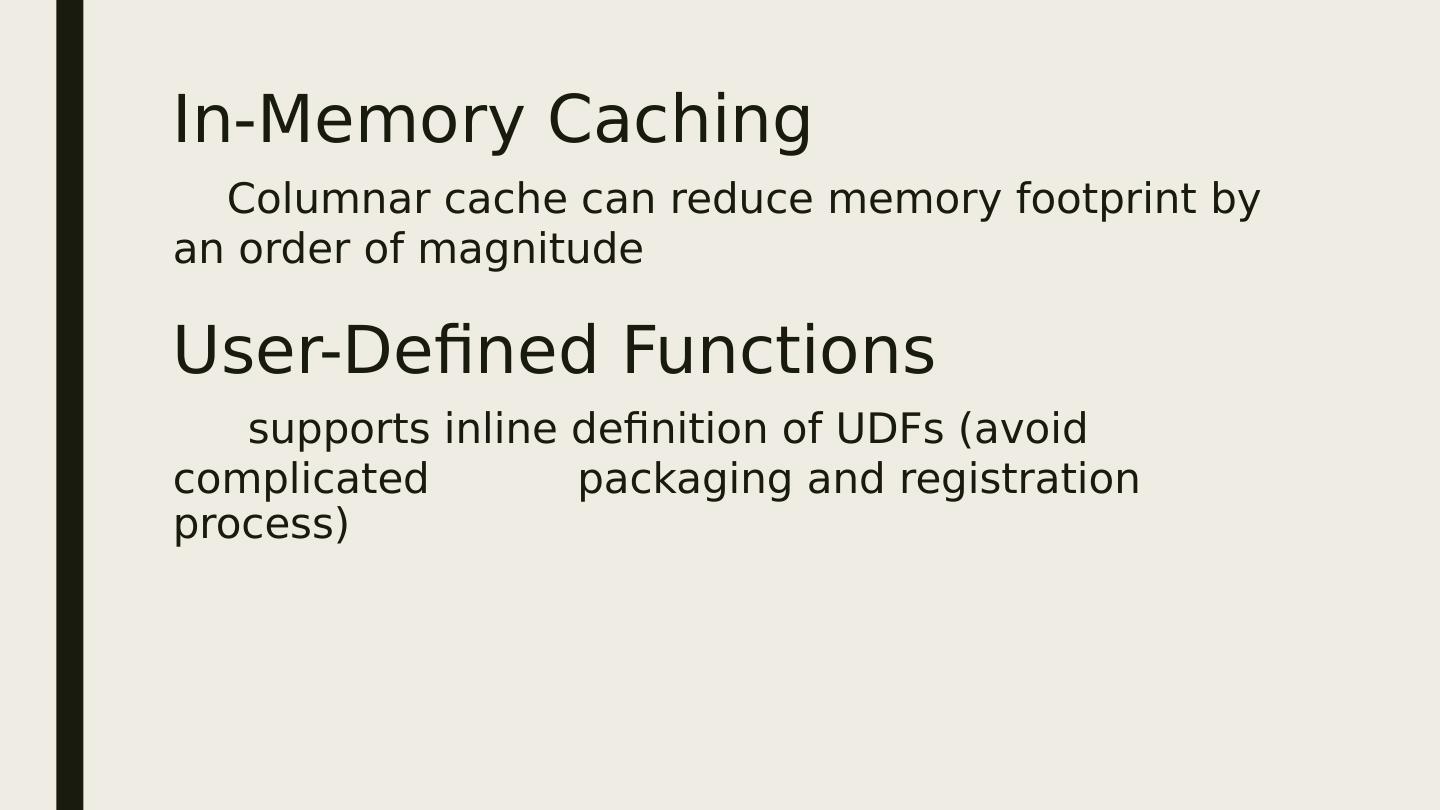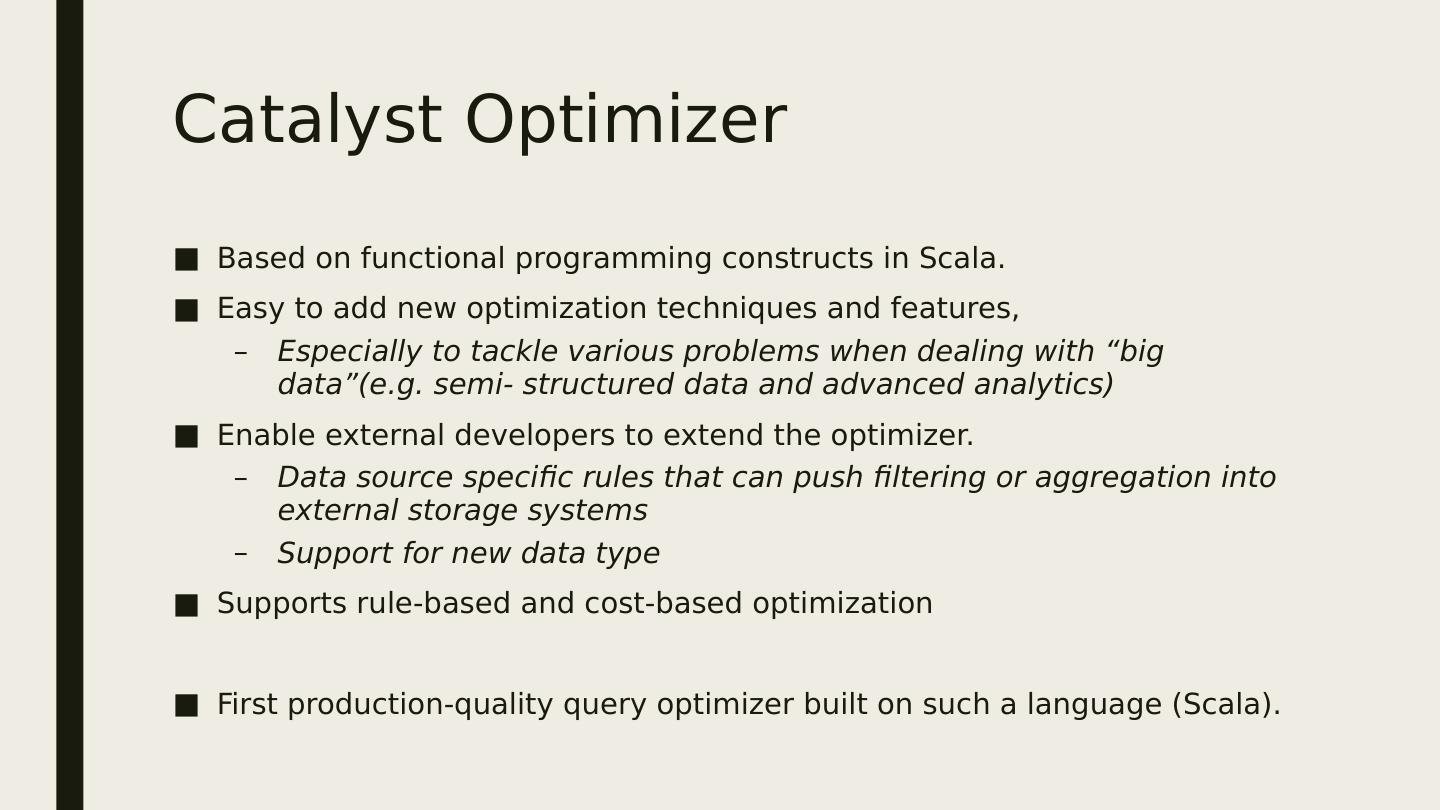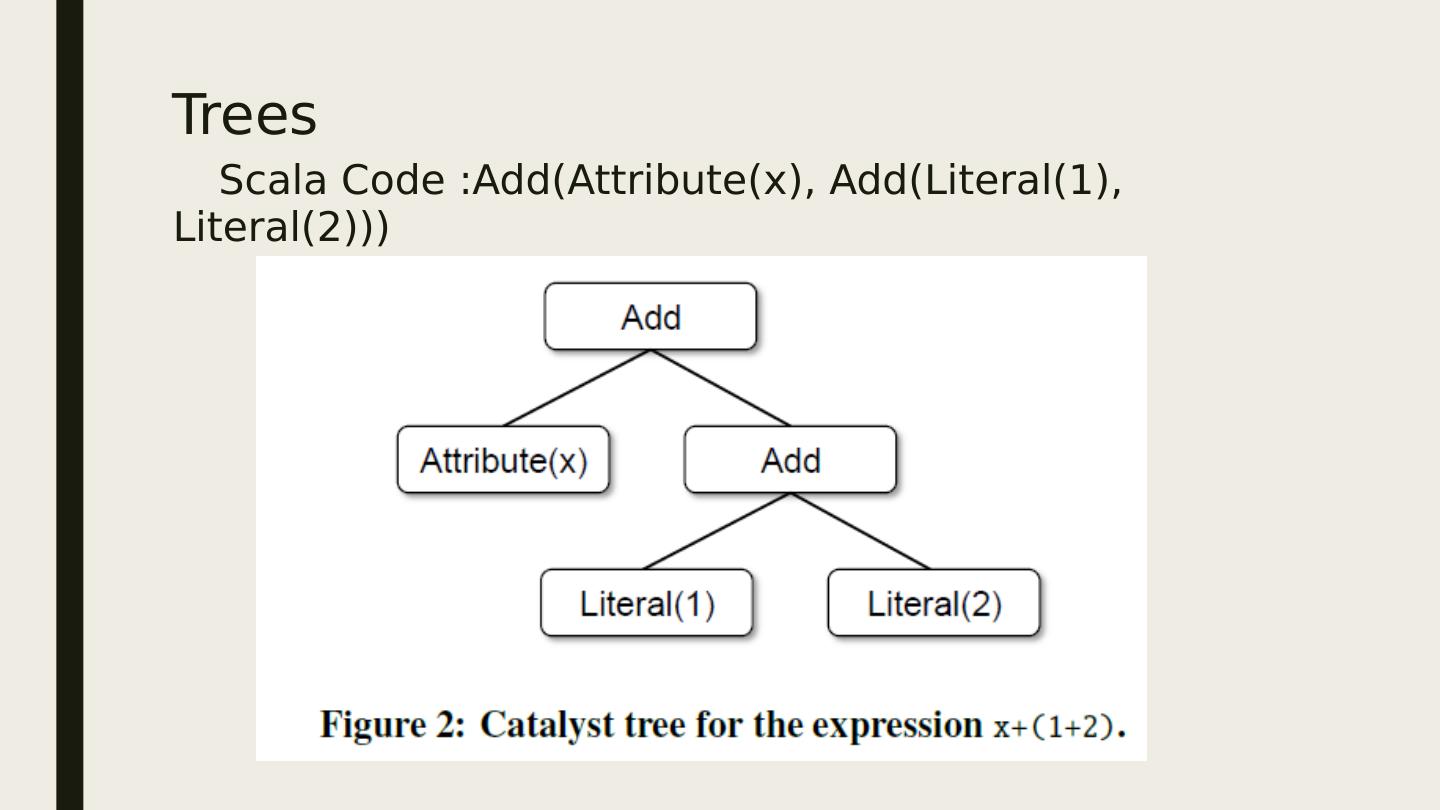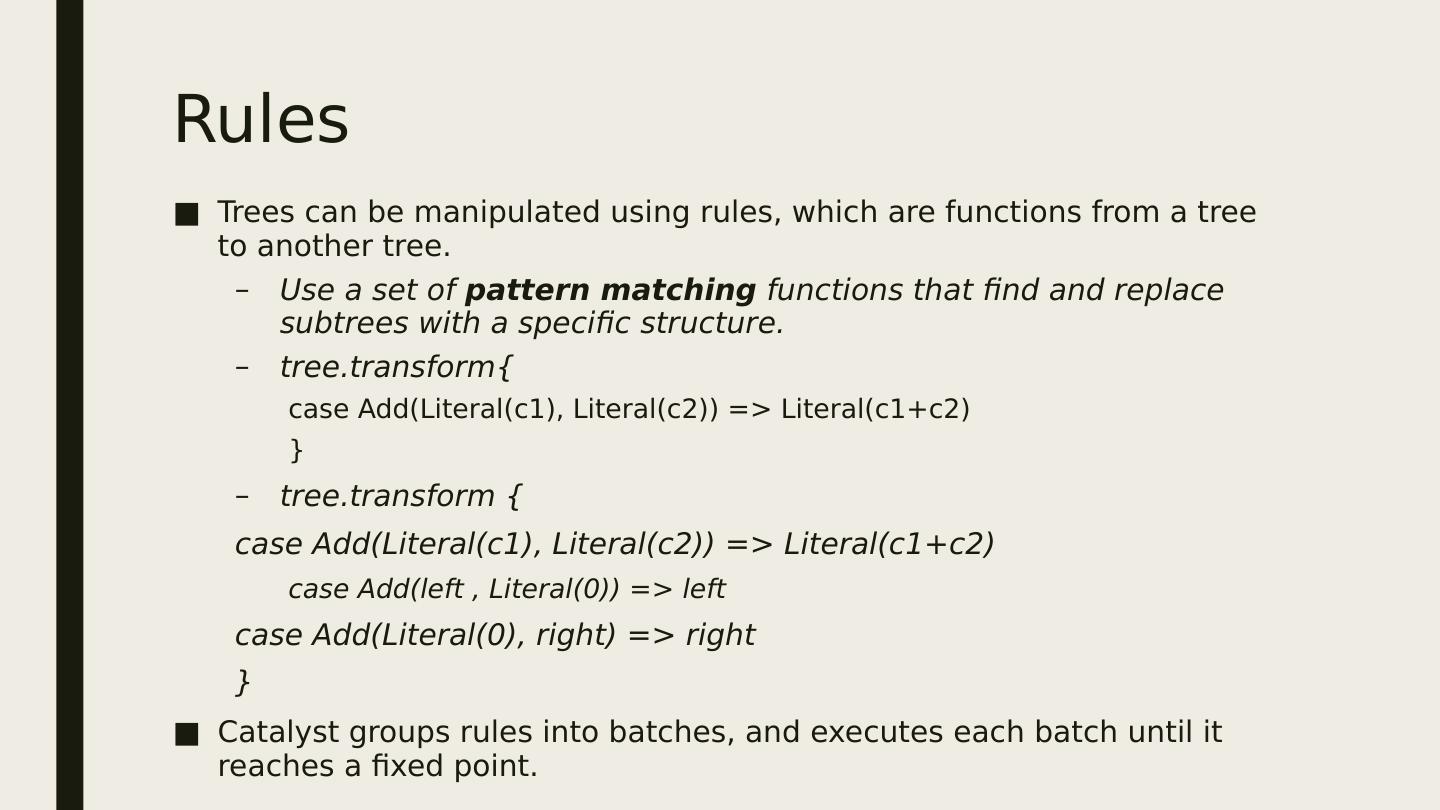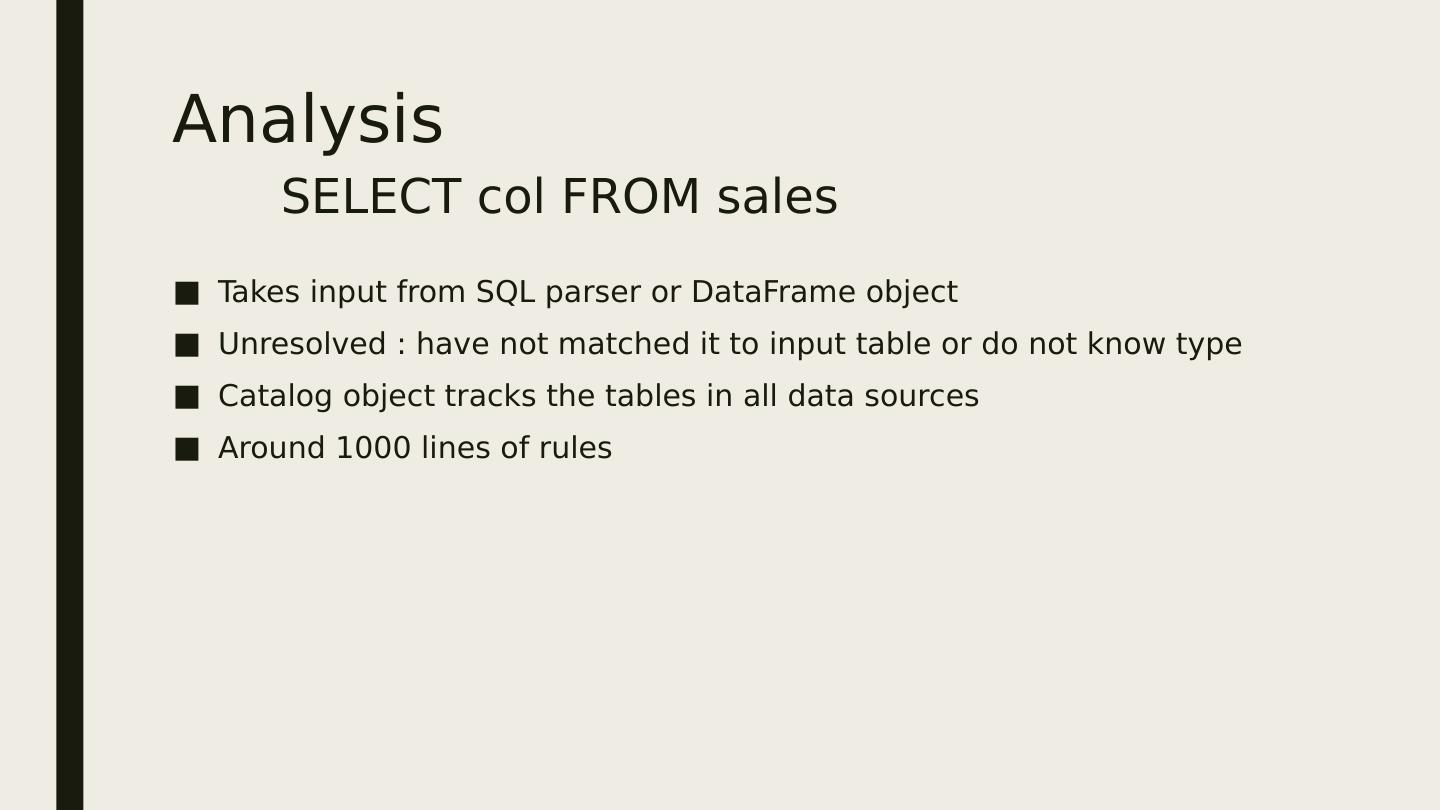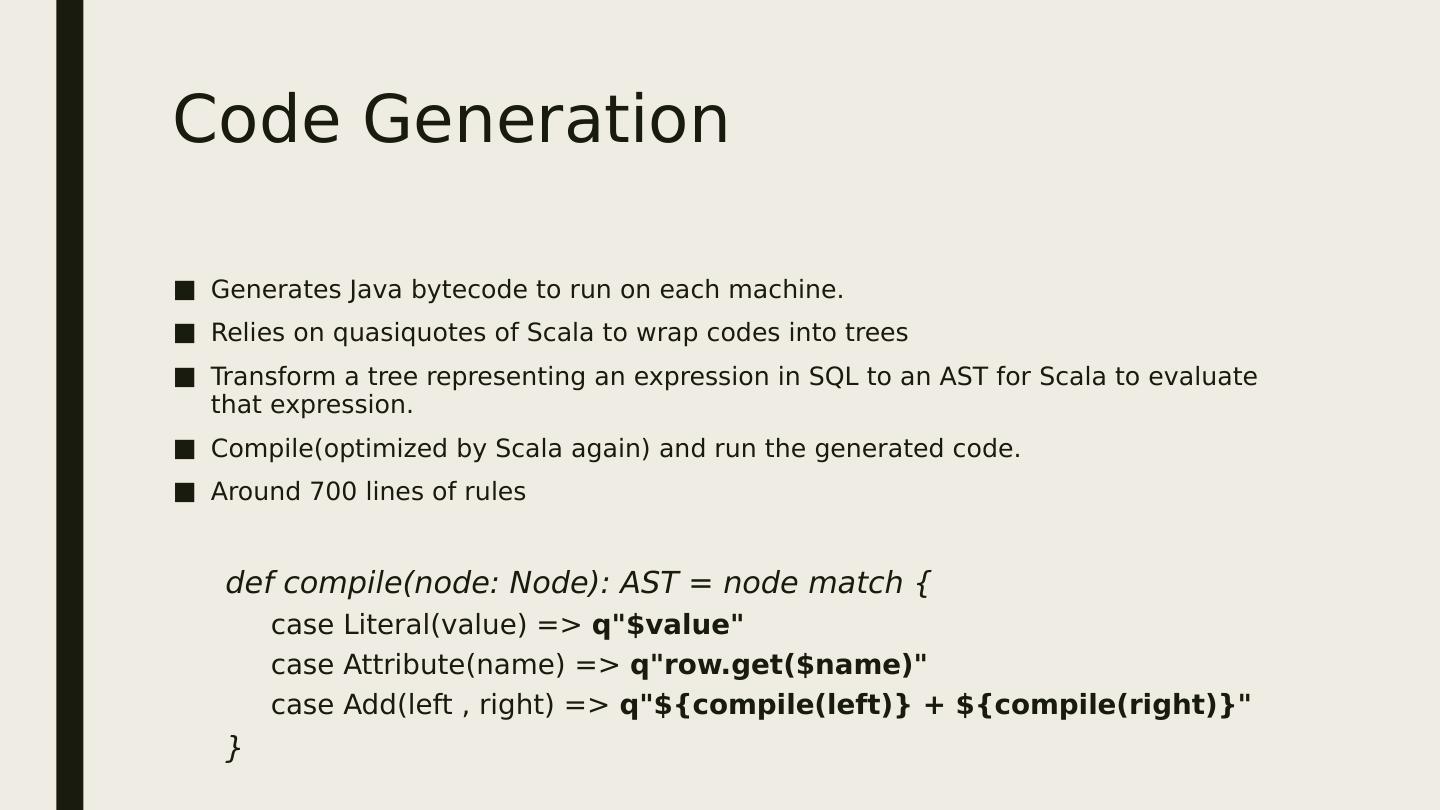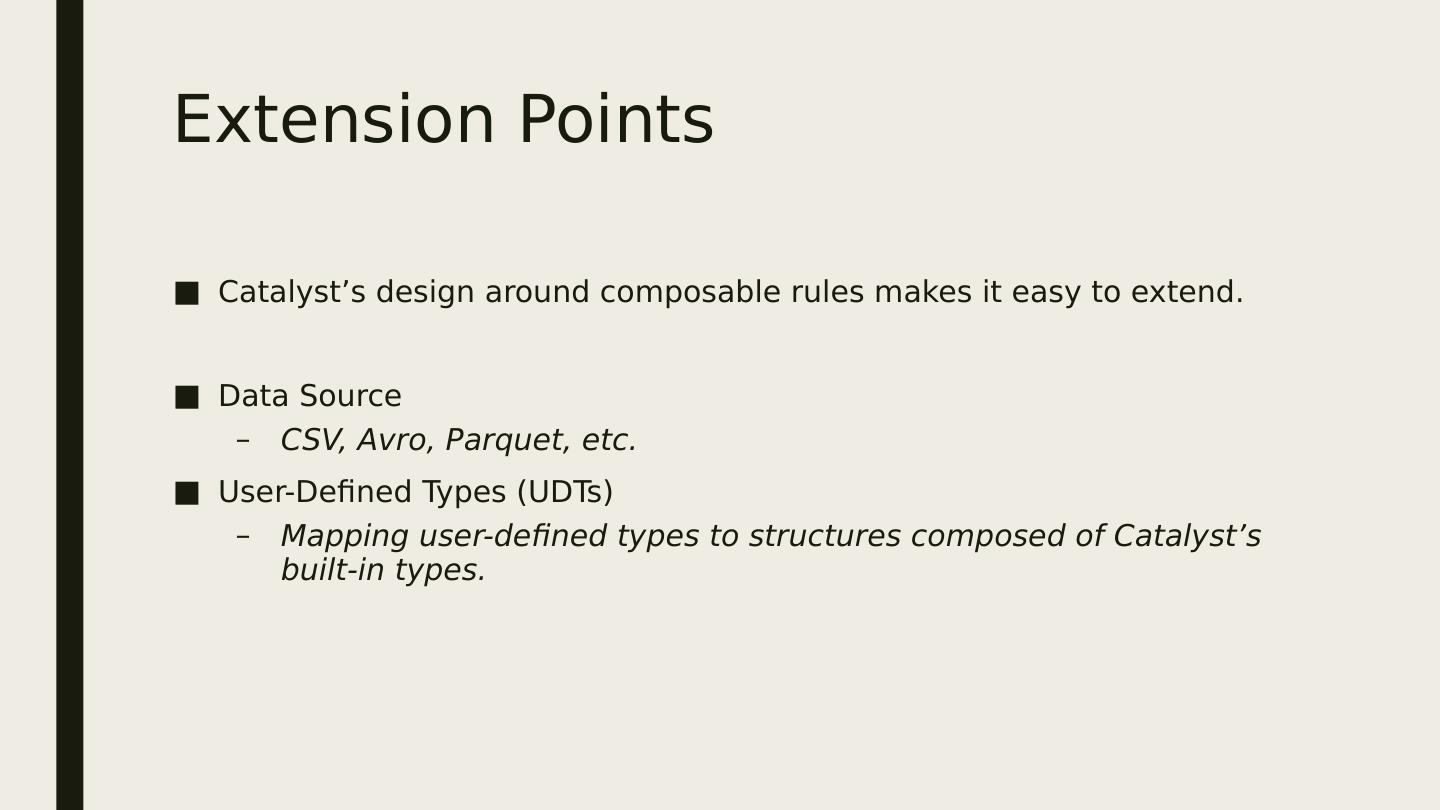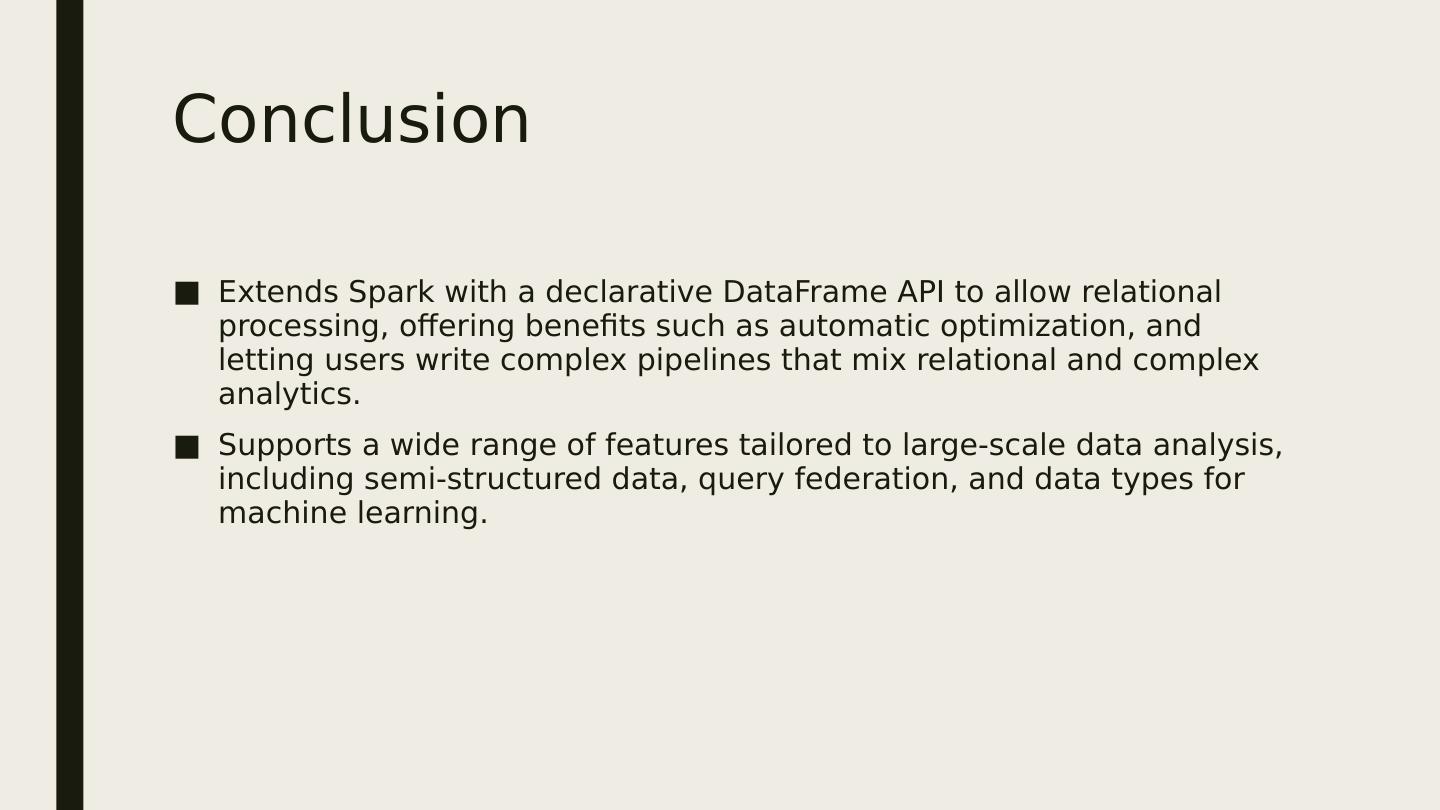- 快召唤伙伴们来围观吧
- 微博 QQ QQ空间 贴吧
- 文档嵌入链接
- <iframe src="https://www.slidestalk.com/u3790/sparksql81621?embed" frame border="0" width="640" height="360" scrolling="no" allowfullscreen="true">复制
- 微信扫一扫分享
spark-sql:Relational Data Processing in Spark
展开查看详情
1 .Spark SQL Relational Data Processing in Spark Junting Lou lou8@illinios.edu
2 .Earlier Attempts MapReduce Powerful, low-level , procedural programming interface. Onerous and require manual optimization Pig, Hive, Dremel, Shark Take advantage of declarative queries to provide richer automatic optimizations . Relational approach is insufficient for big data applications ETL to/from semi-/unstructured data sources (e.g. JSON) requires custom code Advanced analytics(ML and graph processing) are challenging to express in relational system.
3 .Spark SQL(2014) A new module in Apache Spark that integrates relational processing with Spark’s functional programming API. Offers much tighter integration between relational and procedural in processing, through a declarative DataFrame API. Includes a highly extensible optimizer, Catalyst, that makes it easy to add data sources, optimization rules , and data types .
4 .Apache Spark(2010) General cluster computing system. One of the most widely-used systems with a “language-integrated” API. One of the most active open source project for big data processing. Manipulates(e.g. map, filter, reduce) distributed collections called Resilient Distributed Datasets (RDD). RDDs are evaluated lazily.
5 .Scala RDD Example: Counts lines starting with “ERROR” in an HDFS file lines = spark.textFile (" hdfs ://...") errors = lines.filter (s => s.contains ("ERROR")) println ( errors.count ()) Each RDD(lines, errors) represents a “logical plan” to compute a dataset, but Spark waits until certain output operations, count , to launch a computation. Spark will pipeline reading lines, applying filter and computer counts. No intermediate materialization needed. Useful but limited.
6 .Shark First effort to build a relational interface on Spark. Modified the Apache Hive system with traditional RDBMS optimizations, Shows good performance and opportunities for integration with Spark programs. Challenges Only query external data stored in the Hive catalog, and was thus not useful for relational queries on data inside a Spark program(e.g. RDD errors). Inconvenient and error-prone to work with. Hive optimizer was tailored for MapReduce and difficult to extend.
7 .Goals for Spark SQL Support relational processing both within Spark programs and external data sources using a programmer-friendly API. Provide high performance using established DBMS techniques. Easily support new data sources , including semi-structured data and external databases amenable to query federation. Enable extension with advanced analytics algorithms such as graph processing and machine learning.
8 .Programming Interface
9 .DataFrame API: ctx = new HiveContext () users = ctx.table ("users") young = users.where (users("age") < 21) println ( young. count ()) Equivalent to a table in relational database Can be manipulated in similar ways to the “native” RDD.
10 .Data Model Uses a nested data model based on Hive for tables and DataFrames Supports all major SQL data types Supports user-defined types Able to model data from a variety sources and formats(e.g. Hive, RDB, JSON, and native objects in Java/ Dcala /Python)
11 .DataFrame Operations Employees users.where (users("age") < 21) .join( dept , employees(" deptId ") === dept ("id")) . registerTempTable ("young") .where(employees("gender") === "female") ctx.sql ("SELECT count(*), avg (age) . groupBy ( dept ("id"), dept ("name")) FROM young ") . agg (count("name")) All of these operators build up an abstract syntax tree (AST) of the expression, which is then passed to Catalyst for optimization. The DataFrames registered in the catalog can still be unmaterialized views , so that optimizations can happen across SQL and the original DataFrame expressions. Integration in a full programming language( DataFrames can be passed Inter-language but still benefit from optimization across the whole plan).
12 .Querying Native Datasets Allows users to construct DataFrames directly against RDDs of objects native to the programming language. Automatically infer the schema and types of the objects. Accesses the native objects in-place, extracting only the fields used in each query (avoid expensive conversions). case class User(name: String , age: Int ) // Create an RDD of User objects usersRDD = spark.parallelize (List(User("Alice", 22), User("Bob", 19))) // View the RDD as a DataFrame usersDF = usersRDD.toDF
13 .In-Memory Caching Columnar cache can reduce memory footprint by an order of magnitude User-Defined Functions supports inline definition of UDFs (avoid complicated packaging and registration process)
14 .Catalyst Optimizer Based on functional programming constructs in Scala. Easy to add new optimization techniques and features, Especially to tackle various problems when dealing with “big data”(e.g. semi- structured data and advanced analytics) Enable external developers to extend the optimizer. Data source specific rules that can push filtering or aggregation into external storage systems Support for new data type Supports rule-based and cost-based optimization First production-quality query optimizer built on such a language (Scala).
15 .Trees Scala Code :Add(Attribute(x), Add(Literal(1), Literal(2)))
16 .Rules Trees can be manipulated using rules, which are functions from a tree to another tree. Use a set of pattern matching functions that find and replace subtrees with a specific structure. tree.transform { case Add(Literal(c1), Literal(c2)) => Literal(c1+c2) } tree.transform { case Add(Literal(c1), Literal(c2)) => Literal(c1+c2) case Add(left , Literal(0)) => left case Add(Literal(0), right) => right } Catalyst groups rules into batches, and executes each batch until it reaches a fixed point.
17 .Using Catalyst
18 .Analysis SELECT col FROM sales Takes input from SQL parser or DataFrame object Unresolved : have not matched it to input table or do not know type Catalog object tracks the tables in all data sources Around 1000 lines of rules
19 .Logical Optimization Applies standard rule-based optimizations to the logical plan Constant folding Predicate pushdown Projection pruning Null propagation Boolean expression simplification … Extremely easy to add rules for specific situation Around 800 lines of rules
20 .Physical Planning Take a Logical Plan and generates one or more physical plans. Cost-based selects a plan using a cost model.(currently only used to select join algorithm) Rule-based: Pipelining projections or filter into one Spark map operation Push operations from the logical plan into data sources that support predicate or projection pushdown. Around 500 lines of rules.
21 .Code Generation Generates Java bytecode to run on each machine. Relies on quasiquotes of Scala to wrap codes into trees Transform a tree representing an expression in SQL to an AST for Scala to evaluate that expression. Compile(optimized by Scala again) and run the generated code. Around 700 lines of rules def compile(node: Node): AST = node match { case Literal(value) => q"$value " case Attribute(name) => q"row.get ($name)" case Add(left , right) => q"${compile(left)} + ${compile(right)}" }
22 .Performance by using quasiquotes
23 .Extension Points Catalyst’s design around composable rules makes it easy to extend. Data Source CSV, Avro, Parquet, etc. User-Defined Types (UDTs) Mapping user-defined types to structures composed of Catalyst’s built-in types.
24 .Advanced Analytics Features Specifically designed to handle “big data” A schema inference algorithm for JSON and other semi-structured data. A new high-level API for Spark’s machine learning library. Supports query federation, allowing a single program to efficiently query disparate sources.
25 .
26 .Integration with Spark’s Machine Learning Library
27 .SQL Performance
28 .SQL Performance
29 .Conclusion Extends Spark with a declarative DataFrame API to allow relational processing, offering benefits such as automatic optimization, and letting users write complex pipelines that mix relational and complex analytics. Supports a wide range of features tailored to large-scale data analysis, including semi-structured data, query federation, and data types for machine learning.




